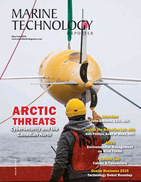Hearing the Light: DAS could Revolutionize Subsea Defense
During the summer of 2020, a group of Norwegian University of Science and Technology (NTNU) marine scientists based on the Svalbard archipelago successfully detected the vocalizations of baleen whales frolicking in Arctic Ocean and North Sea, some 70-90 kilometers away. At first blush this might seem somewhat unremarkable, given that researchers regularly monitor whale behavior, and whalesong has long been known to traverse great distances. But what made this particular set of observations special was the sensor of choice. It wasn’t a hydrophone, the trusted tool of the marine bioacoustics trade. Instead it was pulses of light transmitted through 120 km of undersea fiber optic cable running between the towns of Longyearbyen and Ny-Ålesund.
The NTNU scientists utilized a relatively new and innovative technology known as distributed acoustic sensing, or DAS, which relies on fiber optics to detect pressure waves emanating from acoustic or seismic activity. Using a specialized device known as an interrogator, light pulses are sent along the length of an unused, “dark” fiber at known intervals. When the light encounters tiny defects within the fiber, some of it will be reflected back to the interrogator (a phenomenon known as Rayleigh backscattering). As pressure waves from an acoustic emission impose “nano strains” on the fiber, it causes fluctuations in the reflected light. These fluctuations can then be analyzed and, using advanced signal processing, translated into a unique acoustic signature resulting not only in the detection, but identification and even localization of the source. When DAS is used in a marine environment, the defects along the fiber essentially act as tiny hydrophones, transforming a length of fiber optic cable into a large aperture sensor array. And since acoustic waves can penetrate the seabed, the sensing fibers do not need to be fully exposed to the water column to be effective. Some segments of the cable used in the NTNU project were buried under anywhere from one to two meters of sediment.
Considering that there are 785,000 miles (1.2 million kilometers) of undersea cables strung across the globe, DAS represents a significant breakthrough in ocean observation. Instead of relying on discrete acoustic and seismic sensors dotting the seabed, dark fibers housed within undersea cables anywhere can now be repurposed as kilometers-long sensor arrays, rigged with the equivalent of thousands of hydrophones capable of detecting both biological and anthropogenic noise. In addition to whale vocalizations, DAS has successfully detected surface ships, earthquakes, surface waves, and distant ocean storms, and could even act as a worldwide tsunami warning system.
Given its capability to provide a wide area, persistent sensor network that is already positioned throughout the vastness of the oceans, there is considerable potential for DAS in subsea defense operations – specifically, by providing an additional layer of surveillance coverage, tracking both surface and subsurface targets. DAS could detect and track surface warships, augmenting intelligence gathered from other ISR platforms such as satellites and aircraft. In addition to detecting vessels in transit, DAS may also detect the sounds of dynamic positioning systems, indicating that seabed operations are underway.
 Image courtesy the research article Eavesdropping at the Speed of Light: Distributed Acoustic Sensing of Baleen Whales in the Arctic, found on https://www.frontiersin.org/articles/10.3389/fmars.2022.901348/full#B54
Image courtesy the research article Eavesdropping at the Speed of Light: Distributed Acoustic Sensing of Baleen Whales in the Arctic, found on https://www.frontiersin.org/articles/10.3389/fmars.2022.901348/full#B54
Below the surface, there are applications for undersea warfare. At the moment DAS appears optimized for detecting low frequency emissions (even into the millihertz range), and while modern submarines do emit in the low frequency range, these emissions are also low intensity – according to open source, unclassified estimates, somewhere between 95 and 110 decibels, which is only slightly higher than the ambient noise of the surrounding ocean at around 90 decibels. Given that a decibel is a logarithmic measure (i.e. each 10 decibel increase represents a tenfold increase in acoustic power, 20 decibels, 100 fold, 30 decibels, 1000 fold), compared to the moans of a North Atlantic blue whale, which can exceed 180 decibels, manned submarines generate far less acoustic power.
But at closer range, submarine emissions may be more detectable, particularly by fibers that are resting on the surface of the seabed. Ultimately, DAS may provide more of an anti-submarine warfare (ASW) barrier defense that is confined to smaller regions of water space, rather than a long-range detection and tracking system.There are applications for seabed defense as well. If we consider the types of activity that would be associated with seabed warfare – cable tampering, mine warfare, the emplacement, operation, or destruction of subsea infrastructure – DAS could play a role in the detection, identification, and localization of threats.
Although currently optimized for low frequency detection, DAS does have the capability to detect high frequency emissions as well, such as those generated by vehicle actuators and thrusters, as well as underwater navigation, imaging, and communication technologies. A 2020 MIT study found that small AUVs generate intense emissions in the 15-24 kHz range, which can be 10-45 decibels above the ambient background noise.† A typical DVL emits at anywhere from 400-600 kHz, while SAS emits anywhere from 60-120 kHz. Echosounders emit at high frequencies and at higher levels of intensity – anywhere from 185 to 230 decibels.
And although the propulsion system of a submersible such as a swimmer delivery vehicle (SDV), large displacement UUV (LDUUV), or extra-large UUV (XLUUV) may generate low intensity sound, it may be possible to detect its lower-frequency emissions if they originate at close range.
Underwater construction activity generates low frequency acoustic and seismic waves, and so the noise associated with the emplacement of seabed structures such as energy stations, AUV docking stations, or sensor arrays would be readily detectable by DAS. Freefalling sensor units landing on the seabed might generate a detectable “microseism” – a seismic wave usually associated with small earth tremors. Air dropped mines, crashing through the ocean surface, and thumping to a halt on the seabed, would likely generate powerful acoustic and seismic waves. DAS could potentially assist in the mapping of minefields, providing additional data points to aid in expediting mine countermeasures operations. And as Russia continues to move forward with the development of the Poseidon nuclear-armed, nuclear-powered AUV, DAS could play an important role in an integrated underwater distant early warning and defense system, providing ISR or relaying targeting data to interceptor vehicles.
While DAS shows great promise for defense applications, it does have limitations – at least for now. Its effective range, for example, is roughly 50 to 100 kilometers due to the attenuation of the reflected light during its two-way travel, so a truly large scale DAS array would require some kind of amplification. An integrated DAS defense network would entail comparing sound samples against a database of known acoustic signatures in order to identify threats, and to discriminate between legitimate targets and false alarms. Thus, a high volume of current and timely measurement and signals intelligence (MASINT) will be required for DAS to assist in detecting and identifying emerging subsea threats. "And in addition to the quantity of MASINT data required, the sheer volume of acoustic intelligence (ACINT) generated by DAS will also be daunting."
The NTNU project, for example, generated some seven terabytes of data per day – or nearly 250 terabytes over the course of the study. Nevertheless, even with these challenges, DAS has the potential to greatly influence subsea defense. With a low-cost, low-maintenance, ready-made sensor network already in place throughout the world’s oceans, DAS will likely soon find its way into the defense inventories of friends and adversaries alike.
Source
† Railey, K; DiBiaso, D; Schmidt, H. An acoustic remote sensing method for high-precision propeller rotation and speed estimation of unmanned underwater vehicles, The Journal of the Acoustical Society of America. 2020, 148, 3942.
 About the Author: David R. Strachan is a defense analyst and founder of Strikepod Systems, a research and strategic advisory focusing on autonomous undersea systems.
About the Author: David R. Strachan is a defense analyst and founder of Strikepod Systems, a research and strategic advisory focusing on autonomous undersea systems.
















 February 2025
February 2025



